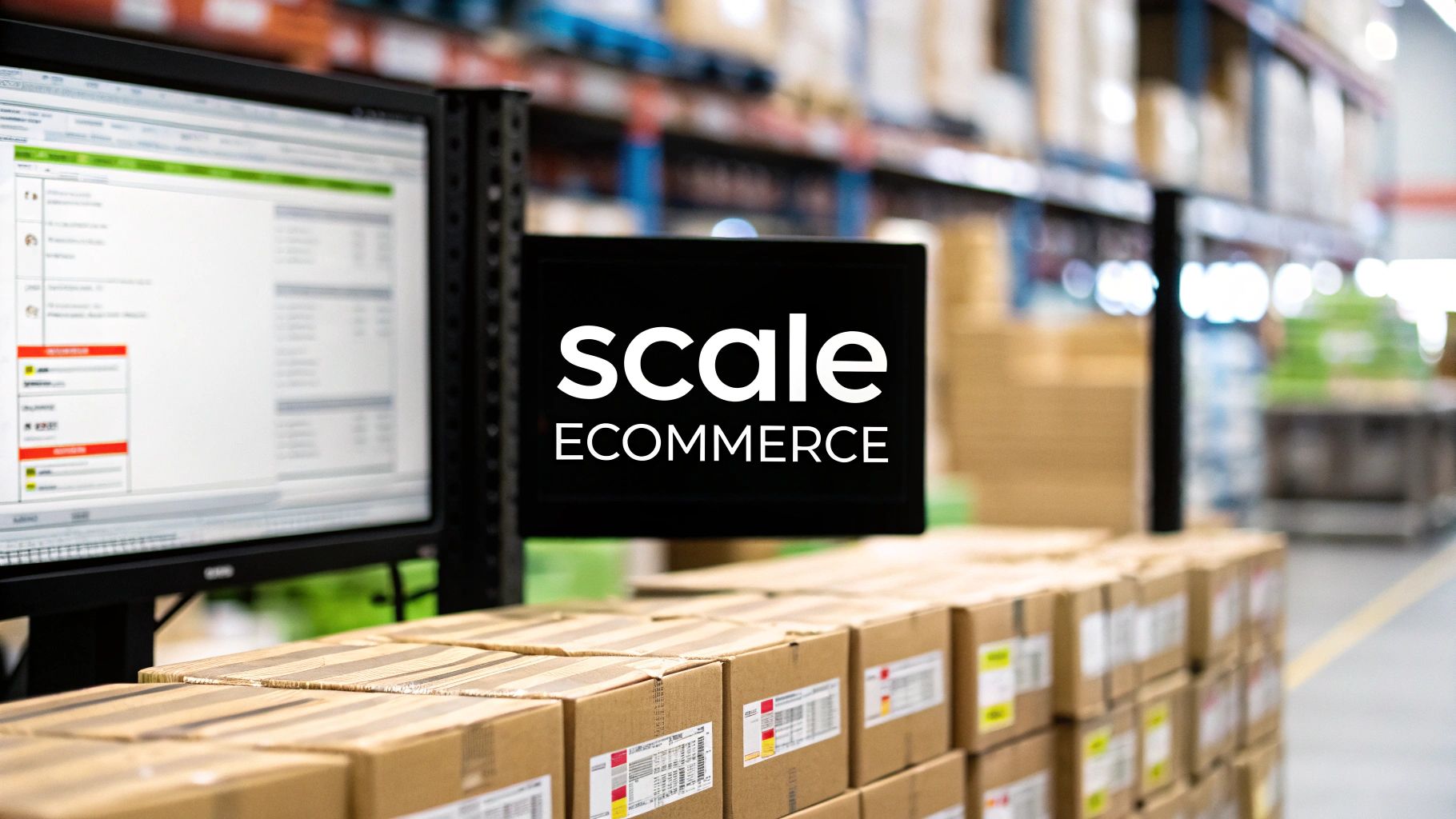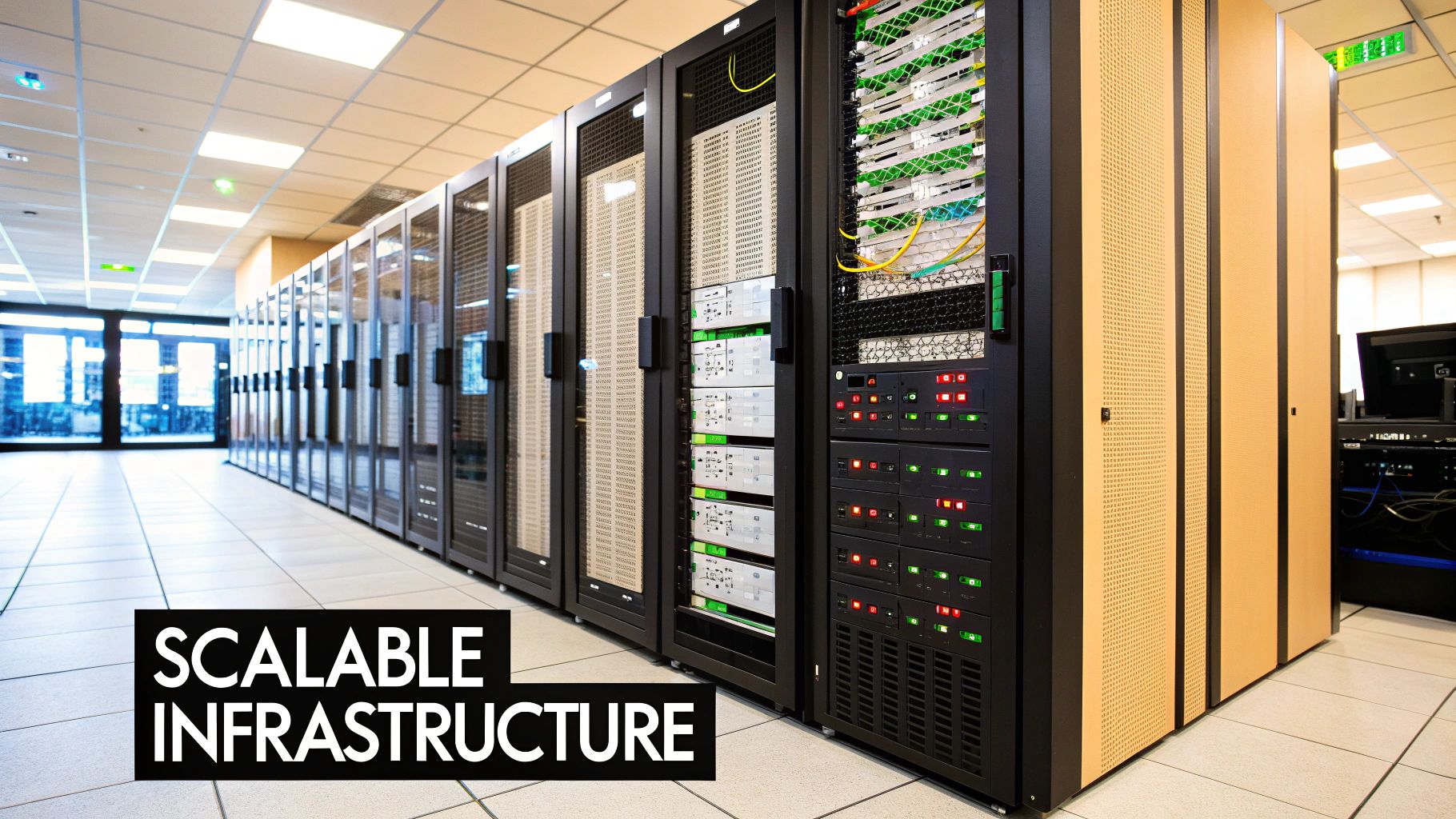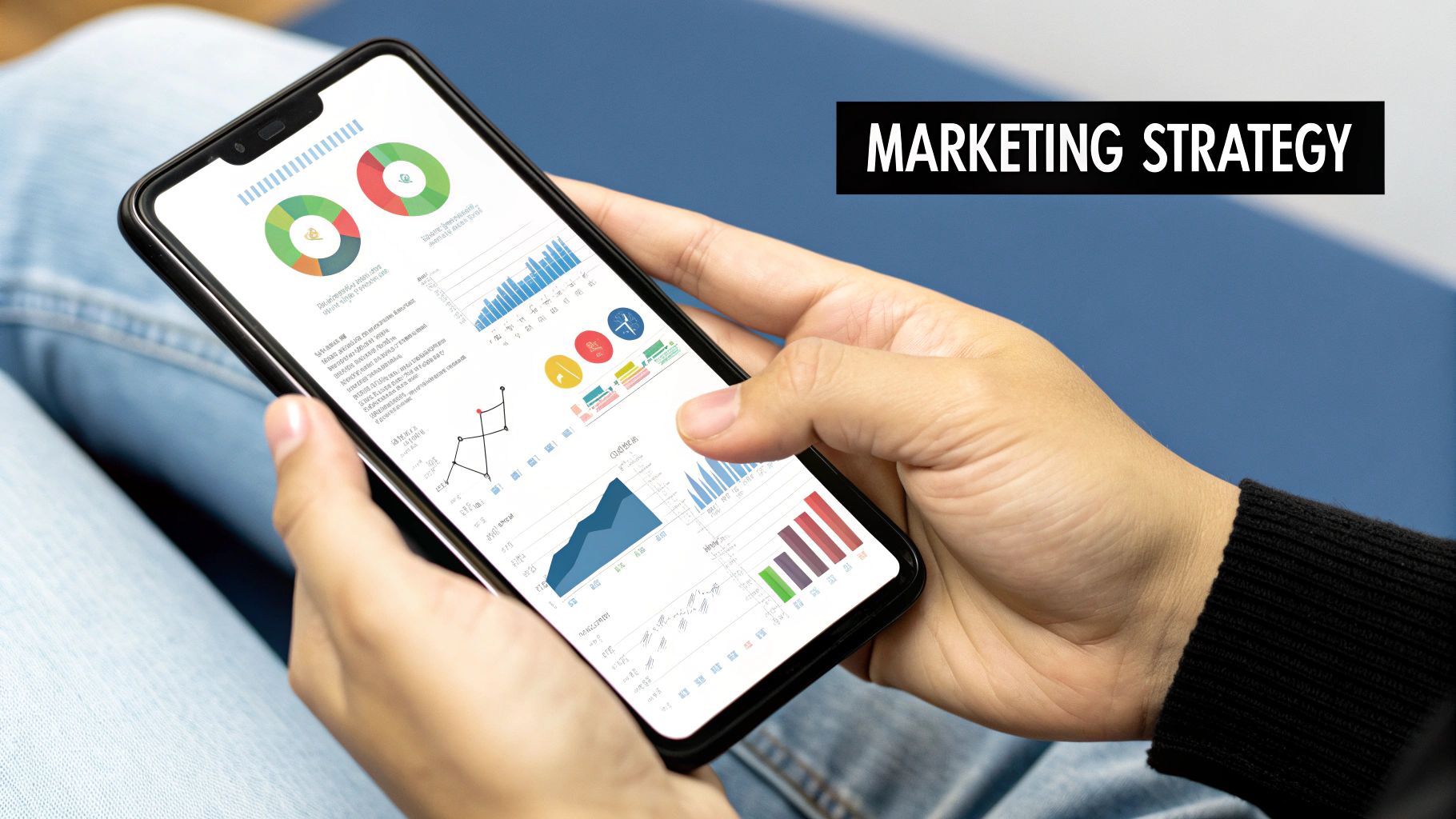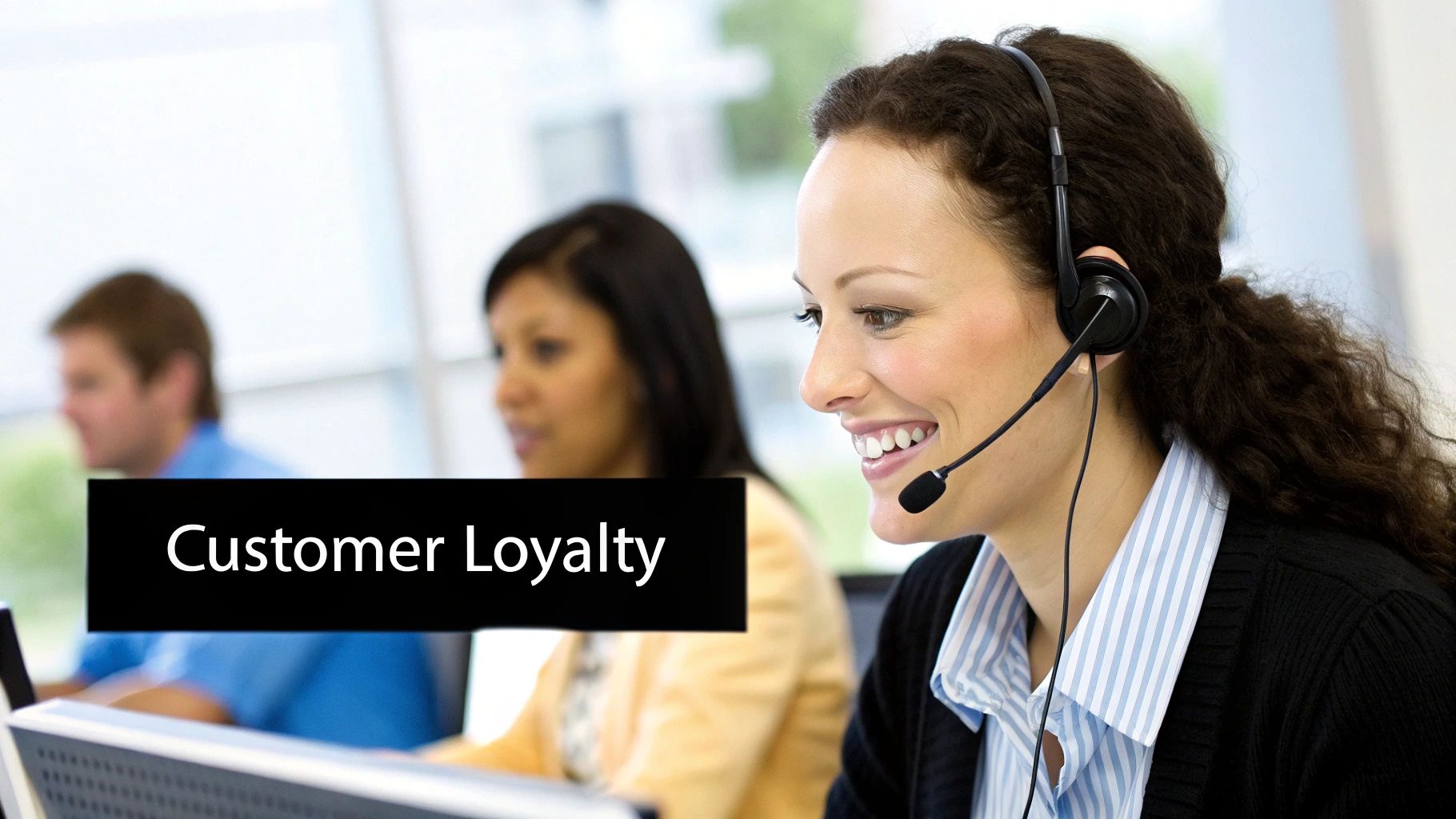Stay Updated with Everything about MDS
Thank you! Your submission has been received!
Oops! Something went wrong while submitting the form.

Chilat Doina
August 25, 2025
Scaling an ecommerce business is a different game entirely from just growing one. It’s about shifting your entire mindset away from just chasing bigger revenue numbers and toward building systems that can last. The real goal is to boost profitability and dial in your operational efficiency. This way, your business can handle a flood of new orders without your costs exploding right along with it.
The formula is surprisingly simple, at least on paper: master your financial metrics, automate everything you can, and don't put all your eggs in one customer acquisition basket.
So many founders get this wrong. They think "scaling" and "growth" are the same thing. They pour every spare dollar into ads to pump up that top-line revenue, and for a while, it feels like progress.
But this often just masks a fragile business model. When your costs scale up at the same rate as your revenue, you’re on a fast track to burnout and serious cash flow problems. True, sustainable scaling is all about building a rock-solid foundation that can actually support that expansion without crumbling under the pressure.
This isn’t about finding some secret marketing hack. It’s the unsexy, nuts-and-bolts work of drilling down into the financial and operational bedrock of your business. Before you can even dream of 10x growth, you need to know your numbers inside and out.
Your journey to scale starts with unit economics—the nitty-gritty of the revenue and costs tied to a single customer. If you only focus on two metrics, make them these: Customer Lifetime Value (CLV) and Customer Acquisition Cost (CAC).
The golden rule here is that your CLV absolutely must be higher than your CAC. A healthy target that many successful brands aim for is a 3:1 ratio. If it costs you $50 to acquire a customer (your CAC), they should be generating at least $150 in profit (your CLV) for you over time. Getting this ratio wrong is one of the most common—and fatal—mistakes I see. Brands will crank up their ad spend, only to realize they’re actually losing money on every single new person they bring in.
Scaling with bad unit economics is like trying to fill a leaky bucket by just adding more water. You’re going to burn through your cash and just make your losses bigger and bigger. You have to fix the leaks first.
Beyond CLV and CAC, a few other key performance indicators (KPIs) tell you if you're truly ready to scale. Forget about vanity metrics like social media followers or website traffic. They look nice on a report, but they don't pay the bills.
Focus on these instead:
This foundational work also means protecting what you’ve built. You can't scale a business that's vulnerable. That's why implementing smart strategies to prevent ecommerce fraud is a non-negotiable step to safeguard both your revenue and your customers.
Let's be clear: this financial discipline is more critical than ever. The global ecommerce market is projected to hit a staggering $6.88 trillion by 2025, with over 28 million businesses all fighting for a piece of the pie.
What’s wild is that about 70% of these are small businesses pulling in under $1 million annually. In a crowded field like that, efficiency is the ultimate advantage. While platforms like Shopify have made it easier than ever to start, the brands that last are the ones with a laser focus on operational and financial excellence. This is the groundwork that allows you to truly scale. You can get a deeper look at the competitive landscape from research published by Link My Books.
It's crucial to understand the difference between metrics that show growth and those that confirm true, sustainable scalability. One tells you you're getting bigger; the other tells you you're getting stronger.
Looking at the right-hand column is what separates the brands that fizzle out from the ones that become household names. Focus on the "better" and you'll be building a business that's meant to last.
Manual tasks are the enemy of scale. Simple as that.
Every minute you or your team spends manually updating spreadsheets, processing orders, or answering the same customer question for the tenth time is a minute you're not spending on strategic growth. This is where so many ecommerce businesses hit a wall; they try to scale revenue while their operations are still stuck in first gear.
As your order volume climbs, these manual processes don't just slow you down—they create costly errors, frustrate customers, and lead to serious team burnout. The answer isn't to just hire more people to do the same repetitive work. The real key to scaling an ecommerce business is building an operational machine that practically runs on its own through smart automation.
Before you can automate anything, you need a painfully clear picture of where your time is actually going. Take a week and track every manual, repetitive task that consumes the most hours. Chances are, you'll see a few usual suspects pop up again and again:
Once you’ve pinpointed these bottlenecks, you can start hunting for the right tools to wipe them out. The goal is to create a seamless flow of information between all your systems, removing the need for a human to touch routine tasks. You can explore a ton of ways to improve operational efficiency that go way beyond just buying new software.
A solid automation strategy is built on a well-integrated stack of software, where every tool talks to the others without a hitch. Think of it less like a collection of separate apps and more like a single, cohesive system. This approach stops data from getting trapped in silos and makes sure that an action in one part of your business automatically kicks off the right response somewhere else.
For most scaling operations, your core stack is going to include:
I saw this firsthand with a mid-sized apparel store that was losing nearly four hours a day to manual order processing. By connecting their Shopify store to their shipping software through an automation tool, they created a workflow that automatically sent order details, printed shipping labels, and emailed tracking info to the customer.
This one simple automation slashed their order processing time by over 60%. The time they got back was immediately poured into improving their marketing funnels and developing new product lines, directly fueling their growth.
Real operational efficiency isn't just about connecting your main systems. The real power comes from creating multi-step workflows that manage complex processes from start to finish with almost zero oversight.
This screenshot from Zapier gives you a glimpse of the thousands of apps you can connect to automate virtually any digital task you can think of.

This visual really gets to the heart of what these connector tools do: they tear down the walls between different software, letting you build custom workflows that fit your exact business needs.
Think about some of these more advanced automation plays:
Building this automated engine isn't a one-and-done project. It’s an ongoing process of hunting down inefficiencies and building systems to fix them. By constantly refining your workflows, you create a business that doesn't just grow—it scales gracefully, efficiently, and profitably.
Relying on a single marketing channel is a huge gamble. It's like building your entire house on one pillar—sure, it's simple, but it's incredibly fragile. All it takes is one algorithm update or a sudden platform policy change to wipe out your entire customer acquisition engine overnight.
To really scale, you need to build a resilient, multi-channel marketing system. This is where different platforms work together, feeding each other, creating a steady, predictable stream of customers. This isn't about just having a profile on every social media app. It's a strategic process of identifying, testing, and scaling new channels that actually make sense for your brand and your audience. When you get it right, you create a powerful flywheel effect where your efforts in one area amplify your results everywhere else.

Scaling your marketing has to be a disciplined process, not just a matter of throwing money at different ad platforms and hoping something sticks. You want to move from guesswork to a data-driven system that proves a channel's potential before you commit a serious budget.
Here’s a simple way to think about it:
The biggest mistake I see founders make is giving up too soon. A new channel rarely crushes it out of the gate. Treat your first campaigns like scientific experiments. You're there to learn, not to chase immediate ROI.
Paid channels like Meta (Facebook and Instagram) Ads and Google Ads are usually the first stop for brands looking to scale. They give you immediate feedback and a direct line to customers. But scaling them profitably is all about precision.
You can't just copy-paste your ads across platforms. A visual, story-based ad that kills it on Instagram will almost certainly bomb as a text-heavy Google Ad. Your creative and copy have to feel native to the environment.
From there, you have to get obsessed with your Customer Acquisition Cost (CAC). If your test campaigns on TikTok are bringing in customers for $25 a pop while Facebook is costing you $60, you have a crystal-clear signal on where to put your next dollar. This data-driven approach to budgeting is what separates the brands that scale from those that burn through cash.
Paid ads are like renting an audience; organic channels like SEO and content marketing are about owning it. These are the assets that build long-term, compounding value and keep paying dividends long after you've invested the time to create them. Think of it as building your brand's real estate on the internet.
Your SEO strategy shouldn't be about chasing broad, hyper-competitive keywords. Instead, focus on long-tail keywords that signal strong purchase intent. For example, instead of just "running shoes," go after "best cushioned running shoes for marathon training." This attracts a much more qualified audience that is way further down the buying funnel.
Pair this with high-value content that actually helps people:
Expanding to marketplaces like Amazon or Walmart can instantly put your products in front of millions of ready-to-buy shoppers. But it’s not a simple copy-paste of your direct-to-consumer strategy. You have to play by their rules, which means optimizing your listings for each platform's unique search algorithm and managing everything from pricing to customer service their way.
At the same time, social commerce has completely blurred the lines between discovering a product and buying it. This is a massive opportunity. By 2025, mobile commerce is projected to account for 59% of total ecommerce sales, with social commerce exploding to $1.2 trillion.
As DesignRush's analysis of ecommerce statistics points out, this trend makes it absolutely essential to optimize your entire business for a mobile-first experience and to integrate shoppable features directly into your social feeds.
By building out this multi-channel engine, you create a much more robust, defensible business. When one channel takes a dip—and it will—the others are there to pick up the slack, keeping your growth steady and predictable. That's how you scale for the long haul.
So, your marketing is humming along and orders are flooding in. This is it. This is the moment where the real test of scaling your ecommerce business begins.
Your supply chain—which probably started with you packing boxes in your garage—is about to get seriously complicated. We're talking sourcing, inventory management, and fulfillment all at once. This is the operational backbone of your brand. If it cracks under pressure, you're looking at stockouts, shipping delays, and a legion of unhappy customers.
A fragile supply chain is the silent killer of so many fast-growing brands. The goal isn't just to be efficient; you need to build a resilient system that can handle huge order surges without tanking the customer experience you've worked so hard to create.
Remember that moment you could no longer see the floor of your spare room for all the shipping boxes? It's a great milestone, but it's also a fork in the road. This is usually when outsourcing fulfillment to a third-party logistics (3PL) provider starts to sound like a really good idea.
Making this leap is about so much more than just getting your space back. It's a strategic move to tap into expertise and infrastructure you could never build on your own. A solid 3PL partner can snag better shipping rates, offer faster delivery from a network of warehouses, and handle the messy reality of returns.
But let's be real, the transition can be scary. You're handing over a huge piece of your customer experience to someone else. That's why vetting potential partners is absolutely non-negotiable.
Choosing a 3PL is like picking a business partner. Their performance is your brand's reputation. A cheap provider that botches deliveries will cost you far more in lost customers than you'll ever save on their fees.
You wouldn't bet your entire business on a single marketing channel, right? So why would you do it with a single supplier? The last few years have been a masterclass in how fast global events can wreck a supply chain. To scale safely, you have to diversify your supplier base.
This doesn't mean you need ten different manufacturers for every single product. It's about being strategic. Identify backup suppliers for your most important products and components. You can start by giving a secondary supplier 10-20% of your production volume. It keeps them in the loop and ready to scale up if your primary partner hits a snag.
Having options is also a fantastic negotiation tool. When suppliers know you're not totally dependent on them, you suddenly have more leverage for better pricing, payment terms, and production priority. Mastering these relationships is a game-changer; you can find some fantastic advice on vendor management best practices to really nail these critical partnerships.
As you grow, "gut feeling" inventory planning stops working. You'll end up with stockouts on your bestsellers while your cash is tied up in products that just won't move. You need to implement a basic inventory forecasting model. Use your past sales data, account for seasonality, and factor in your marketing promotions to predict what you'll need and set up automated reorder points.
The decision of when to bring in automation becomes pretty clear as your order volume climbs. This visual breaks down the tipping point where doing things by hand becomes a serious bottleneck.

The data speaks for itself. Once you cross 100 daily orders, automation isn't just a nice-to-have—it's essential for staying efficient and profitable.
Thinking about going global? That adds a whole new layer of complexity. Every country has its own customs rules, taxes (like VAT), and shipping quirks. Get it wrong, and your packages can get stuck at the border for weeks, which is a surefire way to create a terrible customer experience.
You can sidestep these headaches by working with a 3PL that has international experience or by using services that calculate the landed cost upfront. This ensures a smooth ride for your products—and your customers—across any border.

Let's get one thing straight: you can't do it all yourself. That’s the simple, unavoidable truth every founder hits when they start to scale. The systems and automations you’ve painstakingly built are powerful, sure, but they need people at the helm.
Successfully scaling means making the single most difficult leap of your entrepreneurial journey. You have to stop being the primary "doer" and evolve into a leader and visionary. It means building a team that doesn't just check off tasks but actually owns outcomes.
Your first few hires are everything. They set the cultural tone and create the operational leverage that finally frees you up to think about the big picture. Get this wrong, and you can stall your growth for months. Get it right? It feels like adding rocket fuel to the engine.
Don't just hire to plug a hole. Hire to solve your biggest scaling bottleneck.
Take a hard look at where your time is going. What are the tasks that suck you in for hours and keep you from working on the business instead of in it? For most founders, the first strategic hires fall into three critical areas.
These roles are the bedrock of a scalable team. For a deeper look, this guide on the ideal ecommerce team structure offers a clear roadmap for the roles you'll need as you grow.
In today's market, you aren’t just selling products to customers; you’re selling a vision to potential hires. The best people want more than a paycheck. They want to make a real impact and be part of something meaningful.
Start with your job descriptions. Don't just list duties—sell the opportunity. Talk about the cool problems they'll get to solve and the direct impact their work will have on the company's growth. This approach attracts genuine problem-solvers, not just task-doers.
Your company culture isn't what's written on a poster; it's the sum of the behaviors you reward and tolerate every single day. A strong culture of ownership and accountability is your single best retention tool.
Compensation obviously matters. Do your homework and offer a competitive salary and benefits package. But don't stop there. Consider performance-based incentives that align everyone's goals with the company's success, like bonuses tied to profitability or revenue milestones.
This is the hard part. The skills that got you here—the grind, the hustle, having your hands in absolutely everything—are not the skills that will get you to the next level. Your new job is to set the vision, clear roadblocks, and empower your team to do their best work.
This demands a conscious effort to delegate effectively. It means trusting your team, accepting that they might do things differently than you, and giving them the autonomy to truly own their roles. Micromanaging is the enemy of scale. Period.
As you grow, you'll likely end up with a distributed workforce. Mastering the art of managing distributed teams effectively is no longer optional. This requires crystal-clear communication channels, well-defined expectations, and a culture built on trust, not proximity.
By building a high-performing team, you're not just offloading work. You are creating an organization that can grow, adapt, and thrive far beyond what you could ever achieve alone. This is the human element that turns a successful business into a lasting brand.
As you start to really ramp up your ecommerce business, a ton of questions pop up. It's a familiar path, and a lot of founders run into the same roadblocks. Let's tackle some of the most common ones head-on.
You might think it’s marketing or raising capital, but it’s not. The single biggest hurdle for most fast-growing brands is operations.
So many founders are absolute wizards at creating amazing products and building a cult following, but their businesses start to crumble under the weight of their own success. They hit a ceiling where the manual way of doing things—fulfilling orders, managing inventory, handling customer service—just can't keep up anymore.
This is what we call operational drag. It’s a silent killer that leads to shipping delays, frustrating stockouts, and a customer experience that slowly chips away at all the brand loyalty you've worked so hard to build. The real challenge isn’t working harder; it’s shifting your mindset from being the main "doer" to becoming a systems builder. It’s all about creating a machine with automation and solid processes that can handle the volume without you being the bottleneck.
Adding new products should be a calculated, data-driven move—not a gut feeling or a desperate attempt to have something new. The temptation is real, but launching blindly is a good way to burn cash.
You know it's the right time when the signs are crystal clear. Look for these signals:
Here's a pro tip: Launch your next product as a limited-edition drop or a pre-order campaign. This is the ultimate way to test real-world demand and get cash up-front before you commit to a massive inventory order. You minimize your financial risk and create hype at the same time.
Sure, a great ecommerce platform like Shopify is your foundation. But the single most critical technology for actually scaling is an integration and automation tool.
Think of platforms like Zapier or Make as the central nervous system for your entire business. They’re the glue that connects all your different apps and makes them talk to each other without you having to do anything manually.
These tools link your storefront to your 3PL, your helpdesk to your email list, and your payment processor to your accounting software. This is what unlocks true efficiency. You can automatically push order data to your fulfillment center, sync inventory levels across all your sales channels, and tag new customers in your CRM—all while you sleep. This isn't just a time-saver; it's what makes scaling possible.
This one comes up all the time, and getting it right is fundamental to building a long-term, profitable business.
Simply put, growth is about getting bigger. Scaling is about getting better and more efficient as you get bigger. For any founder serious about building an empire, scaling is the only game that matters. It’s the path to sustainable, hands-off profitability.
Ready to connect with a network of elite founders who have already navigated these scaling challenges? At Million Dollar Sellers, you'll get direct access to the strategies and insights from 7-, 8-, and 9-figure entrepreneurs. Learn more and see if you qualify.
Join the Ecom Entrepreneur Community for Vetted 7-9 Figure Ecommerce Founders
Learn MoreYou may also like:
Learn more about our special events!
Check Events